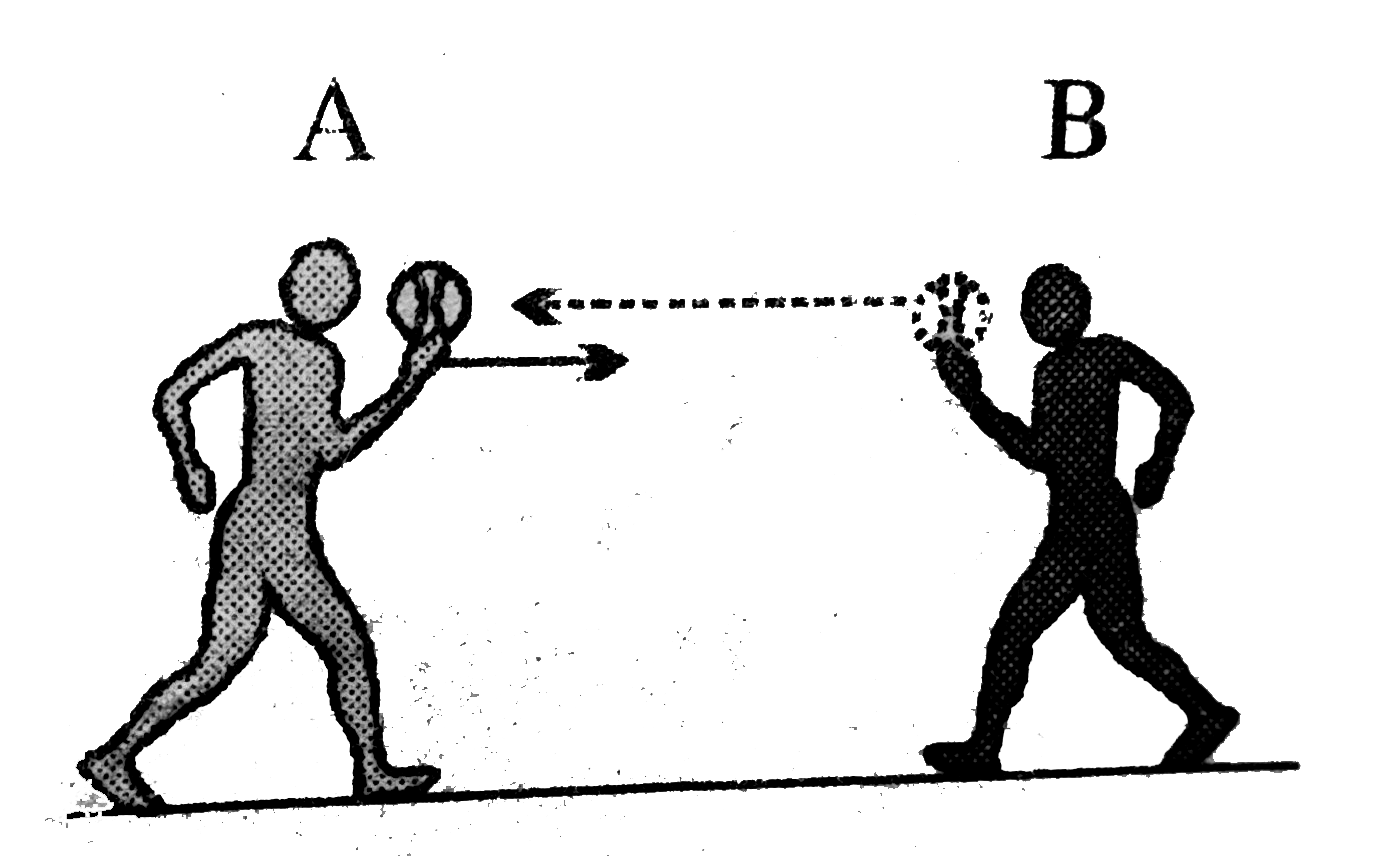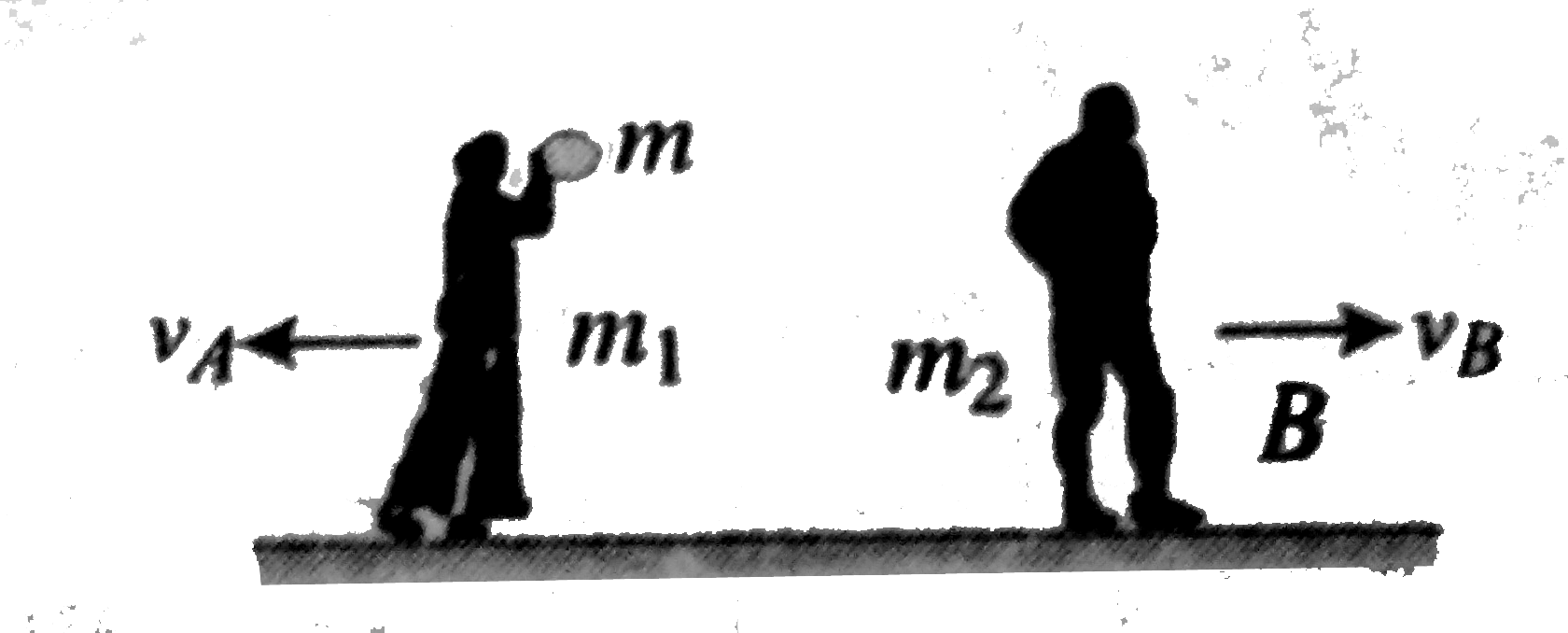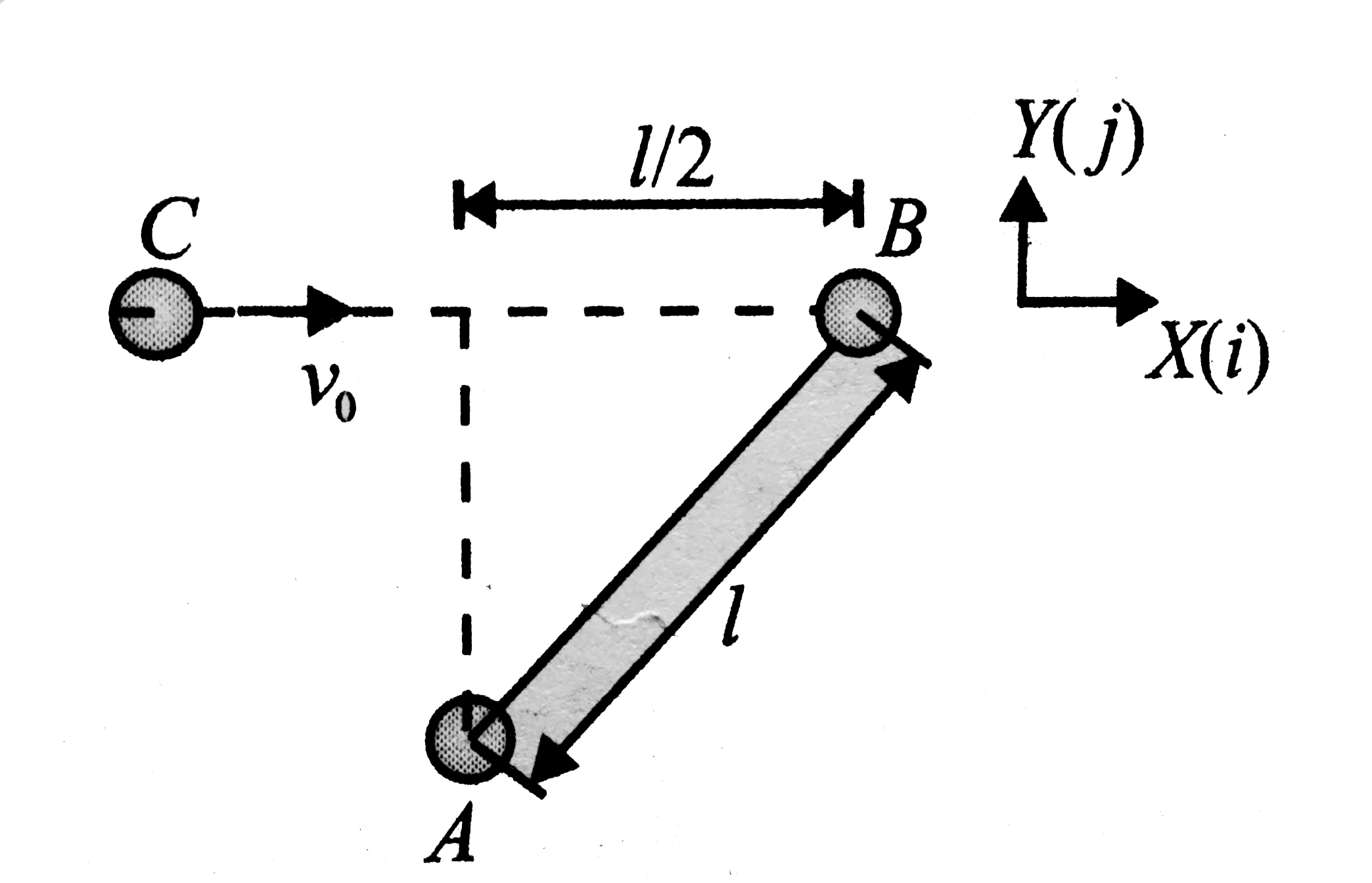Consider two skaters A and B initially at rest on ice -(friction is negligible) with A holding a ball. A has greater mass than B and the ball has some significant mass. A throws the ball to B. B catches it and throws it back to A who catches it again. The magnitudes of the skater's (excluding ball) final velocities, A momentum and kinetic energies (denoted below as v,p and K respectively) are related as

vA=v0
vA<vB,pA<pB
pA=pB,KA<KB
pA<pB,KA<KB
The correct Answer is:B, D
Let after the process of catching is over, final velocites are as shown.
m→ mass of ball
m1→ mass of B
m2→ mass of B

Apply conservation of momentum for entire system.
0=−(m1+m)vA+m2vB
⇒(m1+m)vA=m2vB.........i
Hence m1>m2
⇒vBvA=m1+mm1>1⇒vB>vA
pA=m1vA,pB=m2vB
clearly from and ii pB>pA
KA=12m1v2A=12pAvA
KB=12m2v2B=12pBvB
clearly KB>KA
Topper's Solved these Questions
- CENTRE OF MASSBook:CENGAGE PHYSICSChapter:CENTRE OF MASSExercise:Assertion - Reasoning
Explore 2 Videos
- CENTRE OF MASSBook:CENGAGE PHYSICSChapter:CENTRE OF MASSExercise:Linked Comprehension
Explore 105 Videos
- CENTRE OF MASSBook:CENGAGE PHYSICSChapter:CENTRE OF MASSExercise:Single Correct
Explore 141 Videos
- CALORIMETRYBook:CENGAGE PHYSICSChapter:CALORIMETRYExercise:Solved Example
Explore 13 Videos
- DIMENSIONS & MEASUREMENTBook:CENGAGE PHYSICSChapter:DIMENSIONS & MEASUREMENTExercise:Integer
Explore 2 Videos
Similar Questions
Statement I: In a two-body collision, the momenta of the particles are equal and opposite to one another, before as well as after the collision when measured in the centre of mass frame.
Statement. II: The momentum of the system is zero from the centre of mass frame.
View SolutionThree spheres, each of mass m, can slide freely on a frictionless, horizontal surface. Spheres A and B are attached to an inextensible, inelastic cord of length l and are at rest in the position shown where sphere B is struck by sphere C which is moving to the right with a velocity v0. Knowing that the cord is taut where sphere B is struck by sphere C and assuming 'head on' inelastic impact between B and C, we cannot conserve kinetic energy of the entire system.
 Velocity of A immediately after collision is along unit vector
Velocity of A immediately after collision is along unit vector
View SolutionAn object initially at rest explodes into three fragments A,B and C. The momentum of A is pˆi and that of B is √3pˆj
where p is a+ve number. The momentum of C will be
View SolutionA colorimeter contains 400g of water at a temperature of 5∘C. Then, 200g of water at a temperature of +10∘C and 400g of ice at a temperature of −60∘C are added. What is the final temperature of the contents of calorimeter?
Specific heat capacity of water −1000 cal/kg/K
Specific latent heat of fusion of ice =80×1000 cal/kg
Relative specific heat of ice =0.5
View SolutionTo find the distance d over which a signal can be seen clearly in foggy conditions, a railways-engineer uses dimensions and assumes that the distance depends on the mass density ρ of the fog, intensity (power/area) S of the light from the signal and its frequency f. the engineer finds that d is proportional to S1/n. the value of n is
View SolutionThe mass of a ball A is double the mass of another ball B. The ball a moves at half the speed of the ball. B. Calculate the ratio of the kinetic energy of A to the kinetic energy of B,
View SolutionA ball 'A' of mass 'm' moving along positive x-direction with kinetic energy K and linear momentum "p" undergoes elastic head on collision with a stationary ball 'B' of mass M . After the collision, the ball A moves along negative x-direction with kinetic energy K//9 , the final linear momentum of the ball B is
View SolutionYour physical education teacher throws a ping-pang ball to you at a certain speed an you catch it. The teacher is next going to throw you basket ball whose mass is ten times the mass of the ping-pang ball. You are given the following choices. You can have the basket ball throws with I. The same speed as the ping-pang ball II. The same momentum, or III. The same kinetic energy. rank these choices from easiest to hardest to catch i.e., in order of impulse needed to apply.
View Solutionएक खिलड़ी एक गेंद को किसी कोण पर काफी ऊँचे तक जाने के लिए फेकता है । फेकने के साथ ही खिलड़ी स्वंय भी दौड़ता है ओर गेंद को वापस ज़मीन पर गिरने के पहले पकड़ लेता है । किसका (खिलड़ी का या गेंद का ) औसत वेग अधिक है या दोनों का बराबर है ?
View SolutionA ball of mass moving with a velocity u collides head on with a ball B of mass m at rest. If the coefficient of restitution is e. the ratio of final velocity of B to the initial velocity of A is
View SolutionA ball A of mass m moving along positive x-direction with kinetic energy K and momentum p undergoes elastic head on collision with a stationary ball B of mass M after collision the ball A moves along negative x-direction with kinetic energy K//9 , final momentum of B is
View SolutionA man in a lift throws a ball upwards with velocity v and catches it in time t _(1) when lift is moving up with some acceleration. Again he throws a ball up with same velocity 'V' and catches it in time 't _(2) ' when lift is moving down with same acceleration.Velocity of projection V is
View Solutionएक व्यक्ति किसी गेंद को ऊपर फेंककर 8 सेकण्ड के पश्चात पुनः लपक लेता है तो बतलाइए -
(अ) किस वेग से गेंद को ऊपर फेंका गया था?
(ब) कितनी ऊँचाई पर गेंद का वेग शून्य होगा?
View SolutionA ball is given a speed v on a rough horizontal surface. The ball travels through a distance l on the surface and stops. A. What are the initial and final kinetic energies of the ball? b. What is the work done by the kinetic friction?
View SolutionA ball .A. of mass .m. moving along positive x-direction with kinetic energy .K. and momentum P undergoes elastic head on collision with a stationary ball B of mass .M. . After collision the ball A moves along negative X-direction with kinetic energy K9 Final momentum of B is
View Solution

